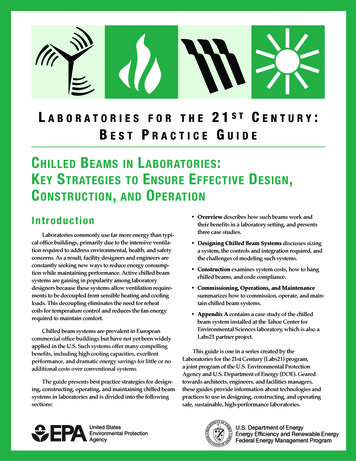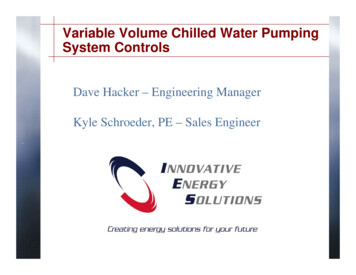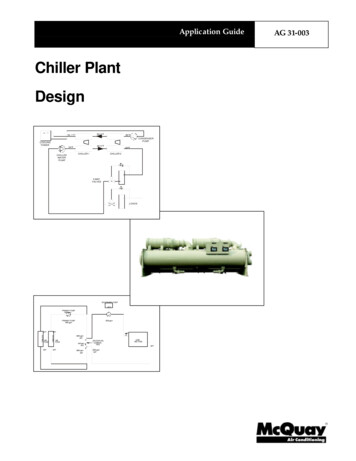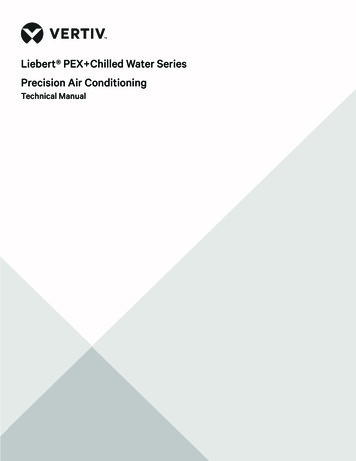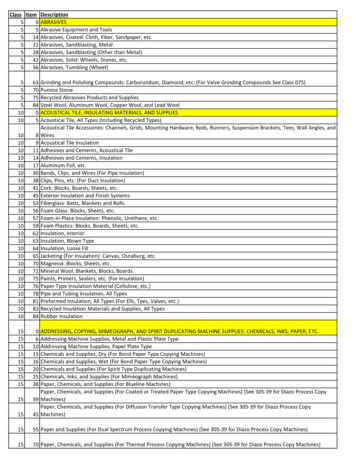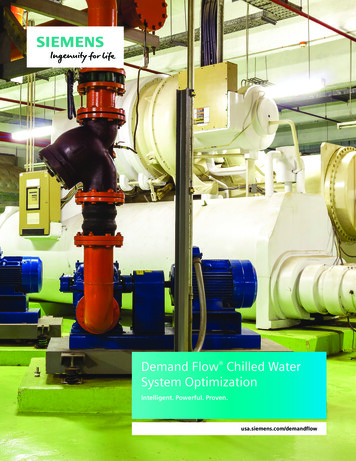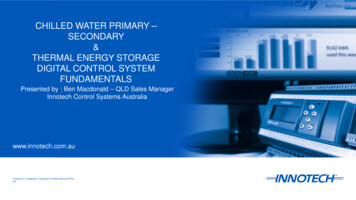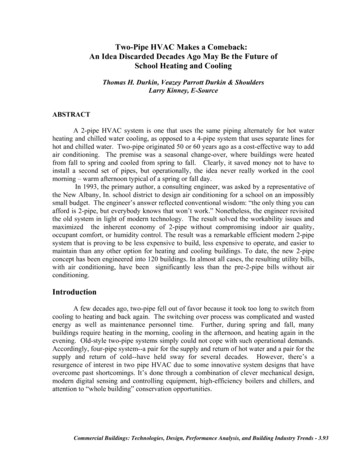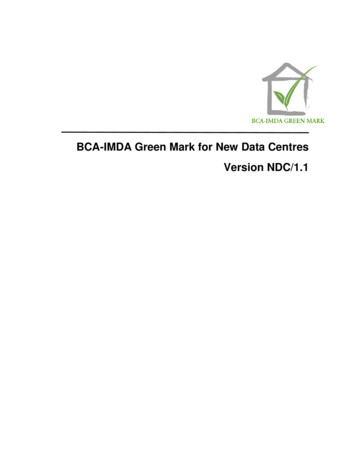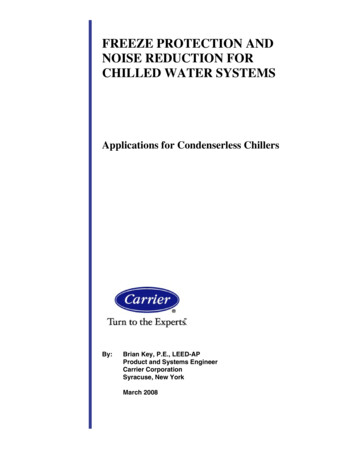
Transcription
FREEZE PROTECTION ANDNOISE REDUCTION FORCHILLED WATER SYSTEMSApplications for Condenserless ChillersBy:Brian Key, P.E., LEED-APProduct and Systems EngineerCarrier CorporationSyracuse, New YorkMarch 2008
TABLE OF CONTENTSADDITIONAL BENEFITS OF CONDENSERLESSCHILLERS . 6INTRODUCTION . 3CHILLER OPTIONS. 3Air-Cooled Chillers . 3-4Remote Evaporator Chiller . 4Condenserless Chiller with RemoteAir-Cooled Condenser. 4NO ANTIFREEZE SOLUTION MEANS LOWERENERGY USAGE . 7CARRIER’S 30HXA CONDENSERLESS CHILLER—THE RIGHT SIZE FOR THE PROJECT . 8Chiller Fits through Standard 36-in. Doorway. 8Smaller Footprint Compared to Remote Evaporator. 8Lower Profile Air-cooled Condenser . 8Wide Capacity Range . 8HFC-134a for Zero Ozone Depletion . 8THE REMOTE EVAPORATOR . 4-5Remote Evaporator Chillers andFreeze Protection . 4Remote Evaporator Chillers andNoise . 5CONDENSERLESS CHILLERS OFFER MANYADVANTAGES COMPARED TO REMOTEEVAPORATOR CHILLERS. 9CONDENSERLESS CHILLER—THE BEST SOLUTIONFOR FREEZE PROTECTION AND NOISEREDUCTION . 5-6Freeze Protection . 5Noise Reduction . 6INTRODUCTIONOne way to answer this question is to reveal where thechiller components are located, as shown in Fig. 1through 3. In these figures, the components inside thered circle are factory assembled and tested.Chilled water systems that use air-cooled outdoorchillers face several challenges.Noise mitigation is a concern for all outdoor chillerslocated where noise generated by equipment maydisturb building neighbors and local residents.Air-Cooled ChillersAll components of an air-cooled chiller are locatedoutdoors. This means that the evaporator barrel, thedevice that cools the working fluid, is exposed to coldambient temperatures. If the working fluid is water, itis very likely that the water will freeze when outdoortemperatures fall below 32 F unless special freezeprotection measures are taken. In many applications,an antifreeze solution is added to the working fluid tominimize its freeze potential. As noted previously,noise transmission from the chiller and thedisadvantages of antifreeze solutions are issuesassociated with this type of chilled water system.In addition, outdoor chillers installed in northernclimates suffer the effects of cold outdoortemperatures and the costs associated with freezeprotection. Antifreeze solutions can provideprotection, however, there are drawbacks to beconsidered. Some antifreeze fluids can be hazardous.Also, the use of antifreeze increases the fluid viscosityand the associated pumping energy, reducing heattransfer capability and decreasing efficiency. Energyperformance is not a feature that most building ownersare willing to sacrifice, especially if they are seekingLEED certification points.This white paper will address the requirements offreeze protection and noise reduction in chilled watersystems and demonstrate that the solution may befound in the placement of the freeze-sensitive andnoise-generating components of the system.CHILLER OPTIONSWhat is the difference between an air-cooled chiller,a remote evaporator chiller, and a condenserlesschiller?Fig. 1. Air-Cooled Chiller3
Remote Evaporator ChillerTHE REMOTE EVAPORATORThe remote evaporator chiller is an air-cooled chillerwith the evaporator physically removed from theoutdoor chiller and placed indoors. Suction and liquidrefrigerant lines must be field designed and installedby the contractor for each project. This configurationdoes isolate the evaporator barrel from the coldoutdoor temperatures. However, outdoor noise, fieldfabricated suction lines, compressor service access andindoor space requirements all pose issues that must beconsidered.Is an air-cooled chiller with remote evaporator theanswer?Remote Evaporator Chillers and Freeze ProtectionAs described above, one way to overcome the freezeissue is to place the chiller’s evaporator barrel indoors,while the compressors and air-cooled condensersection remain outdoors. These components areconnected by field-installed suction and liquidrefrigerant piping located between the remoteevaporator and the outdoor compressor/condensersection as shown in the Fig. 4.Fig. 2. Remote Evaporator ChillerCondenserless Chiller with Remote Air-CooledCondenserFig. 4. Typical Air-Cooled Chillerwith Remote EvaporatorThe condenserless chiller with a remote air-cooledcondenser places the evaporator and compressorsindoors. This type of system isolates the evaporatorbarrel from the cold outdoor ambient temperatures.Locating the compressor indoors provides for easierservice and noise control. The remote air-cooledcondenser located outdoors is smaller in size, haslower sound levels, and is significantly lighter weightcompared to an air-cooled chiller of similar capacity.Although it may be tempting to use this system toovercome the freeze issue, an examination of thedesign requirements and application sensitivities ofthis arrangement reveals several concerns.The refrigerant suction line carries refrigerant gas andlubricating oil back to the compressor. These fieldpiped suction lines must be designed and installedproperly to ensure sufficient refrigerant flow and oilreturn to the compressor. Some of the consequences ofimproper suction line design and installation are: Improper oil return - Without oil, compressionefficiency will suffer and excessive wear can result.A thin film of oil is needed to create a seal betweenthe rotors on a screw compressor. Without oil,compression efficiency suffers. The lack of oil willlead to low oil pressure nuisance alarms, equipmentshut-down and, if not attended to, prematurecompressor failure.Fig. 3. Condenserless Chiller withRemote Air Cooled Condenser4
Undersized suction line – An undersized suctionline will reduce chiller performance and possiblyallow refrigerant to return to the compressor. Withany positive displacement reciprocating or screwcompressor, liquid return can cause immediatecompressor failure since liquids are noncompressible.level of an air-cooled chiller can be as much as20 dB-A higher than the sound level of a remote aircooled chiller, which results in a noticeable differencein comfort.CONDENSERLESS CHILLER—THE BESTSOLUTION FOR FREEZE PROTECTION ANDNOISE REDUCTION Oversized suction line – An oversized suction linecan cause low refrigerant velocities in the pipe. Theability of the pipe to carry oil back to the compressoris a function of the refrigerant velocity. If thevelocity is too low, poor oil return can result. Thelack of oil can lead to nuisance alarms or compressorfailures as previously described.Freeze ProtectionAdvantage of Locating the Compressors andEvaporator IndoorsCondenserless chillers bring the evaporator andcompressors together in a single package locatedindoors, where the working fluid is not exposed tocold outdoor temperatures. The compressor andevaporator components are connected to hot gas andliquid line extending to a remote air-cooled condenserlocated outdoors. This arrangement, shown in Figure5, eliminates the issues associated with the use ofantifreeze and offers several other advantages. Suction line losses – Any friction loss in the suctionpipe translates into a loss in chiller capacity. Lesscapacity reduces energy efficiency and increasesenergy consumption. The length of suction lines inremote evaporator applications can result in a loss ofcapacity of up to 3% which is often not accountedfor in design requirements. Field-applied suction accumulators - Some chillermanufacturers require the application of specialfield-installed suction accumulators. This fieldfabricated device, which can be hundreds of feet inlength, is required to increase the storage volume ofthe suction line. This is necessary to retainrefrigerant in the suction line during the off-cycle. Ifthe accumulator is undersized or overlooked, liquidrefrigerant can be drawn into the compressorresulting in catastrophic compressor failure.Fig. 5. Typical Condenserless Chiller withRemote Air Cooled CondenserApplication of remote evaporators relies heavily on thecontractor’s field expertise along with properengineering of refrigerant piping and accumulators. Ifnot properly engineered and carefully installed, energypenalties will result and at worst, equipment failurecan result. The responsibility of a proper design restswith the consulting engineer while the responsibility ofthe installation rests with the contractor.As a result of locating the compressor and evaporatorindoors, freeze protection is provided without fielddesigned and installed suction lines. Condenserlesschillers use hot gas and liquid lines that are sized bysimply following the manufacturer’s recommendedpipe sizing tables. The job site variations associatedwith the suction line installation and suctionaccumulator sizing are completely eliminated. Withcondenserless chillers, all suction piping is factorydesigned and installed in a quality-controlled assemblyprocess. This arrangement eliminates concerns overfield design and installation of the suction piping thatis so critical to efficient and reliable chiller operation.Remote Evaporator Chillers and NoiseAn air-cooled chiller with remote evaporator hascompressors located outdoors as previously shown inFig. 4. These compressors will transmit noise tosurrounding neighbors and adjacent rtments buildings, and schools located withinhearing distance of the air-cooled chiller are all subjectto the effects of objectionable noise levels. The soundPlacing the compressor and evaporator indoors alsoallows easier access to critical chiller components forservice and maintenance purposes.5
ADDITIONAL BENEFITS OFCONDENSERLESS CHILLERSNoise ReductionRemote Air-Cooled Condensers Have Lower SoundLevels Compared to Air-Cooled ChillersComparing the outdoor sound pressure for a remoteair-cooled condenser versus an air-cooled chillershows a dramatic increase in sound levels as shown inFig. 6. Air-cooled chillers are simply louder thanremote air-cooled condensers, by up to 20 dB-A.Locating the compressor and evaporator indoors canprovide benefits beyond freeze protection and noisereduction.Other benefits to consider are: Easier serviceability – The compressor becomesmuch more accessible compared to outdoor orrooftop mounted chiller equipment. Technicians canwalk right up to the compressor located in themechanical room for easy access to the importantchiller components. No antifreeze fluids required – Eliminates thehazards associated with some antifreeze solutions.Using water eliminates the energy losses associatedwith higher viscosity and heat transfer inefficienciesof the antifreeze solutions. Significantly smaller footprint – Some remoteevaporator packages at 250 tons are 60 inches wide.Carrier’s condenserless chiller at 270 tons can fitthrough a standard 36-in door way. Reduced roof loading – The air-cooled condensersused with condenserless chillers are lighter weightcompared to air-cooled chillers with compressors,condensers, and evaporators filled with the workingfluid. Some 250-ton air-cooled chillers have anoperating weight in excess of 18,500 pounds, whiletwo air-cooled condensers sized for a 250-tonsystem weigh less than 6,100 pounds, which is lessthan half the weight. With the condenserless chillerlocated indoors and the air-cooled condenserslocated outdoors, structural steel and equipmentrigging costs are lower. Lower profile air-cooled condensers – Architectsusually desire outdoor HVAC equipment with a lowvertical profile to make it easier to screen theequipment from view. Some 250-ton air-cooledchillers reach upwards of 95 inches. However,remote air-cooled condensers for the same 250-tonsystem are only about 42 inches high––that’s lessthan half the profile of an air-cooled chiller, makingremote air-cooled condensers much easier to hidefrom view. Increased condensing surface from hot gas lines –The purpose of the air-cooled condenser is to coolthe high temperature refrigerant gas to a liquid. Thehot gas line actually contributes to the condensingprocess by cooling the hot gas before the refrigeranteven enters the condenser. The hot gas linecontributes to this cooling process by adding“surface area” efficiency to the condenser.Sound Pressure ComparisonSound Pressure (dBA) at 30 Feet fromSourceAir-Cooled Chiller vs. Remote 75200225250Capacity (Tons)Air-Cooled ChillerRemote Air-Cooled CondenserFig. 6. Sound Pressure (db-A) for Air-CooledScrew Chillers versus Condenserless Chillerwith Remote Air-Cooled CondensersHow do we react to increased sound pressure? Table Aprovides a rule for the effect on hearing changes atboth high and low frequency levels. With upwardsof 20 dB-A difference in sound pressure levels, aircooled chillers are certainly much louder than theremote air-cooled condensers for the same capacitychilled water system.Table AEffects on Hearing for High and Low FrequenciesIncreased Sound Pressure(Decibel)Effect on HearingHigh Frequencies (above 125 Hz Octave Band)1 dBNot Noticeable3 dBJust Perceptible5 dBNoticeable10 dBDouble20 dBMuch LouderLow Frequencies (125 Hz and Below Octave Band)3 dBNoticeable5 dBDouble10 dBMuch Louder6
savings can be realized. Using Carrier’s HourlyAnalysis Program (HAP), a typical 2-story high schoolbuilding in Indianapolis has an annual energy costsavings as shown in Fig 7.NO ANTIFREEZE SOLUTION MEANSLOWER ENERGY USAGECan Carrier’s 30HXA condenserless chiller saveenergy while providing freeze protection?Table BImpact of Use of 40% PG Antifreeze Solutionon Air-Cooled Chiller PerformanceOne advantage of the condenserless chiller is theprotection against cold ambient temperatureconditions without the use of antifreeze. It is importantto note that some applications will require a suitableantifreeze solution to minimize the potential offreezing. In particular, protection of the chiller fromleaving fluid temperatures of 40 F or lower willrequire the use of an appropriate concentration of anantifreeze solution. This is necessary to protect thecooler barrel from freezing due to cold saturatedsuction temperatures while the chiller is producing thecold leaving fluid temperatures. Also, antifreezesolutions must be used to protect chilled water pipingthat may be exposed to outdoor temperatures belowfreezing. Antifreeze is also necessary to protect chilledwater coils that may be exposed to freezing enteringair temperatures or for coils installed in air handlingunits that are installed outdoors in areas prone toexposure to cold ambient conditions.PG – Propylene GlycolEnergy can be saved by reducing the fluid viscosityand improving the heat transfer coefficients typicallyassociated with antifreeze solutions. Reduced viscosityreduces the chilled water pump energy while improvedheat transfer improves chiller efficiency. Both of thesefactors offer very desirable outcomes when systemenergy is considered.Fig. 7. Annual Cost Summary for an Air-CooledChiller with 40% Antifreeze Solution vs.Condenserless Chiller with Fresh WaterA 20% annual energy savings can be realized for thechiller, air-cooled condenser and chilled water pumpsin this example. These savings can contribute to moreLEED points and a reduction in greenhouse gases suchas CO2. Reductions in energy consumption todaydemonstrate a willingness to preserve resources so thatthey may be enjoyed by future generations.Toxicity issues associated with ethylene glycol canlead to selecting less toxic antifreeze solutions such aspropylene glycol. Many designers choose antifreezesolution concentrations of up to 40% for cold climatesystems. Higher concentrations increase energydemands due to viscosity and heat transfer losses.Table B shows the impact of adding a 40% propyleneglycol solution to an air-cooled chiller sized for a 250ton load with 44 F/54 F LWT/EWT and 95 F ambientair temperature. Note: A significantly larger chillerwas needed to provide the required capacity whenusing the antifreeze solution.Further energy savings can be achieved by combiningthe condenserless chiller, located indoors, with aremote evaporative condenser that can be locatedoutdoors. This type of condenser includes thecondenser coils, acoustically tuned fans, water sump,spray nozzles, a small spray pump and essentialcontrols. The system uses a spray mist of water tolower the refrigerant temperature through evaporationof the water. Evaporation relies on the outdoor air wetbulb temperature which is often lower than the outdoordry-bulb temperature. This results in lower refrigeranttemperatures, lower system pressures and lowerenergy consumption. This white paper focuses onapplications using remote air-cooled condensers.However, it is important to acknowledge the energysavings potential of this alternative type of remotecondenser.Projects seeking LEED Certification will appreciatethe ability to reduce energy costs through applicationof condenserless chillers, while at the same timeproviding a suitable means to protect the chiller fromcold ambient temperatures. A comparison of an aircooled screw chiller with an antifreeze solution to acondenserless chiller with factory matched air-cooledcondenser using fresh water reveals the extent of thisbenefit.If the annual energy costs are evaluated for a 250- toncondenserless chiller system, significant energy7
CARRIER’S 30HXA CONDENSERLESSCHILLER—THE RIGHT SIZE FOR THEPROJECTCarrier’s 30HXA chiller and matched air-cooledcondenser offer a wide range of application flexibility.Chiller Fits through Standard 36-in DoorwayCarrier’s 30HXA chiller conveniently fits through astandard 36-inch doorway making rigging easier andreducing installation costs (Fig. 8).Lower Profile Air-Cooled CondenserCompared to a 250-ton air-cooled chiller, the aircooled condenser matched specifically to Carrier’s30HXA condenserless chiller is less than half theheight (Fig.10).Fig. 10. Low Profile of Carrier’s 30HXA ChillerCompared to an Air-Cooled ChillerWide Capacity RangeCarrier’s 30HXA is available in capacities rangingfrom 70 to 270 tons to match many job requirements.Combinations of two or more chillers can furtherincrease the chiller plant capacity.Fig. 8. Carrier’s 30HXA Chiller Fits throughStandard 36-in. DoorwaySmaller Footprint Compared to RemoteEvaporatorsWith indoor mechanical space at a premium, whywould a building owner want to increase the expanseof non-leasable space? The width of the 30HXAchiller is significantly smaller than a similar capacityremote evaporator system on the market today (Fig. 9).Fig. 9. Indoor Space Comparison – Carrier’s 30HXAChiller and a Remote Evaporator Chiller at 250 TonsHFC-134a for Zero Ozone DepletionWith the phase-out of HCFC-based refrigerantsimminent, Carrier’s 30HXA chiller with HFC-134arefrigerant offers zero ozone depletion potential and nophase-out (Fig. 11).Fig. 11. Montreal Protocol Refrigerant Phase-Out8
CONDENSERLESS CHILLERS OFFER MANYBENEFITS COMPARED TO REMOTEEVAPORATOR CHILLERSCondenserless chillers offer:Carrier’s 30HXA condenserless chiller (Fig. 12.)provides many benefits beyond excellent freezeprotection and easier noise reduction when comparedto a remote evaporator chillers. Easier freeze protection Lower outdoor sound levels—even lower withcondenser fan option Smaller indoor footprint Lower outdoor profile—can be as low as3 ft-7 in. Factory-tested suction piping Lower installed cost - no exterior soundbarrier/wall required No hail guard required with Carrier’s 09AZcondensers Reduced roof loading and construction cost Easier maintenance with indoor equipment Easier fit into the building Long-term refrigerant with zero ozonedepletion HFC-134a Lower energy usage helps contribute toLEED CertificationFig. 12. Carrier’s 30HXA Condenserless Chiller9
Copyright 2008 Carrier Corporationwww.carrier.com04-581023-01Printed in U.S.A.30802-08
a remote evaporator chiller, and a condenserless chiller? One way to answer this question is to reveal where the chiller components are located, as shown in Fig. 1 through 3. In these figures, the components inside the red circle are factory assembled and tested. Air-Cooled Chillers All components of an air-cooled chiller are located outdoors.

